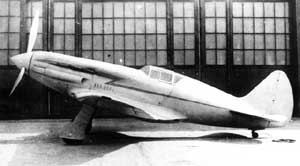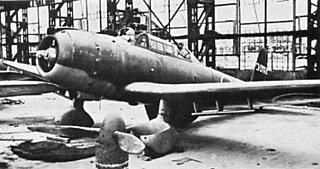Operators
 Soviet Union
Soviet Union
| UT-3 | |
|---|---|
| Role | Twin-engined trainer |
| National origin | USSR |
| Manufacturer | OKB Yakovlev |
| Designer | A.S. Yakovlev |
| Primary user | VVS |
| Number built | ~21 |
| Variants | Yakovlev Ya-19 |
The Yakovlev UT-3, initially known as the AIR-17 and then Ya-17, was a twin-engine low-wing monoplane aircraft designed by Alexander Sergeyevich Yakovlev for the Soviet Air Force (VVS).
The UT-3 was to serve as a training aircraft for pilots of multi-engine aircraft and for training air gunners, bomb aimers, navigators and radio operators. The airframe was constructed largely of wood and fabric-covered mild steel tubing. The prototype was powered by imported French Renault 6Q-01 220 hp (160 kW) six-cylinder inline engines but production aircraft may have used the Voronezh MV-6 (Soviet-built Bengali 6 copy).
Testing was undertaken in 1938 and the aircraft was approved for construction as the UT-3. While the prototype had been fitted with 2x 7.62 mm (0.300 in) ShKAS machine guns and racks for four FAB 50 bombs, the production model was unarmed and more austere. Production was ordered in 1940 at two factories, No. 135 in Leningrad and No. 272 in Kazan. Only around thirty aircraft were built before orders were cancelled as the VVS high command decided to use multi-engine combat aircraft, modified for dual control, in place of dedicated training types.
Despite a seemingly bright future, the UT-3 was only produced in limited numbers, due to slow development and the cessation of MV-6 and Kossov MG-31F engine production.
Data from OKB Yakovlev, [1] Yakovlev aircraft since 1924 [2]
General characteristics
Performance

The Mikoyan-Gurevich MiG-1 was a Soviet fighter aircraft of World War II that was designed to meet a requirement for a high-altitude fighter issued in 1939. To minimize demand on strategic materials such as aluminum, the aircraft was mostly constructed from steel tubing and wood. Flight testing revealed a number of deficiencies, but it was ordered into production before they could be fixed. Although difficult to handle, one hundred were built before the design was modified into the MiG-3. The aircraft was issued to fighter regiments of the Soviet Air Forces (VVS) in 1941, but most were apparently destroyed during the opening days of Operation Barbarossa, the German invasion of the Soviet Union in June 1941.

The Yakovlev UT-2 was a single-engine tandem two-seat low-wing monoplane that was the standard Soviet trainer during the Great Patriotic War. It was used by the Soviet Air Force from 1937 until replaced by the Yakovlev Yak-18 during the 1950s.

The Yakovlev UT-1 was a single-seater trainer aircraft used by the Soviet Air Force from 1937 until the late 1940s.

The Shvetsov M-11 is a five-cylinder air-cooled radial aircraft engine produced in the Soviet Union between 1923 and 1952.

The Yakovlev Yak-9 is a single-engine, single-seat multipurpose fighter aircraft used by the Soviet Union and its allies during World War II and the early Cold War. It was a development of the robust and successful Yak-7B fighter, which was based in turn on the tandem-seat advanced trainer known as the Yak-7UTI. The Yak-9 started arriving in Soviet fighter regiments in late 1942 and played a major role in retaking air superiority from the Luftwaffe's new Focke-Wulf Fw 190 and Messerschmitt Bf 109G fighters during the grand Battle of Kursk in summer 1943.

The Yakovlev Yak-18 is a tandem two-seat military primary trainer aircraft manufactured in the Soviet Union. Originally powered by one 119 kW (160 hp) Shvetsov M-11FR-1 radial piston engine, it entered service in 1946. It was also produced in China as the Nanchang CJ-5.

The Tupolev ANT-7, known by the VVS as the Tupolev R-6, was a reconnaissance aircraft and escort fighter of the Soviet Union. The R-6 traces its roots back to early 1928 when the Soviet Air Force needed a long-range multirole aircraft. The requirements were that it could be used for long-range transport, defensive patrolling, reconnaissance, light bombing and torpedo attack.

The Yakovlev Yak-2 was a short-range Soviet light bomber/reconnaissance aircraft used during World War II. It was produced in small numbers, and most of them were destroyed during the opening stages of Operation Barbarossa.

The Yakovlev Yak-7 was developed from the earlier Yak-1 fighter, initially as a trainer but converted into a fighter. As both a fighter and later reverting to its original training role, the Yak-7 proved to be a capable aircraft and was well liked by air crews. The Yak-7 was simpler, tougher and generally better than the Yak-1.

The Yakovlev Yak-15 was a first-generation Soviet turbojet fighter developed by the Yakovlev design bureau (OKB) immediately after World War II. The main fuselage was that of Yakovlev Yak-3 piston-engine fighter modified to mount a reverse-engineered German Junkers Jumo 004 engine. The Yak-15 and the Swedish Saab 21R were the only two jets to be successfully converted from piston-power to enter production. 280 aircraft were built in 1947. Although nominally a fighter, it was mainly used to qualify piston-engine-experienced pilots to fly jets.

The Yakovlev Yak-6 was a Soviet twin-engined utility aircraft, developed and built during World War II. It was used as a short-range light night bomber and a light transport.
The Nikitin NV-2 was a single-seat sporting aircraft produced in the USSR from 1935.
The Yakovlev Yak-5 was an experimental trainer aircraft designed by Yakovlev OKB in the Soviet Union, and first flown in 1944.
The Tupolev DB-1 (ANT-36) was a Soviet long-range bomber developed in the 1930s. It was developed from the Tupolev ANT-25 distance record-breaking aircraft. Development was prolonged and it was recognized as obsolete by the time it was in production. Only eighteen were built and all were withdrawn from service in 1937.

The Yakovlev Yak-200 was a prototype Soviet multi-engine trainer built during the 1950s. A modified version was built as the Yak-210 for navigator training, but only one example of each was built before the program was cancelled in 1956.

The Yokosuka D3Y Myojo was a Japanese two-seat dive bomber/trainer designed and built by the Yokosuka Naval Air Technical Arsenal. Derived from the Aichi D3A, it was made nearly entirely of wood in an attempt to conserve valuable resources. Upon Japan's surrender, the project came to a halt with only a few aircraft delivered as the Navy Type 99 Bomber Trainer Myojo Model 22.
The Renault 4P, also called the Renault Bengali Junior, was a series of air-cooled 4-cylinder inverted in-line aero engines designed and built in France from 1927, which produced from 95 hp (71 kW) to 150 hp (110 kW).
The Yakovlev Ya-19,, was a 5-seat light transport aircraft developed directly from the Yakovlev UT-3 during the late 1930s. The Ya-19 did not enter production, despite positive results from flight trials, due to the lack of development of the UT-3 and cancellation of the Voronezh MV-6 engine program, which were the result of changing priorities in the face of the Great Patriotic War.
The Yakovlev Ya-21,, was a single-seat high-speed sport aircraft / fighter-trainer designed and built in the Soviet Union in the late 1930s.

The Moskalyev SAM-13 was a prototype twin-engined single-seat low-wing fighter built in the Soviet Union in the 1930s.
| Wikimedia Commons has media related to Yakovlev aircraft . |